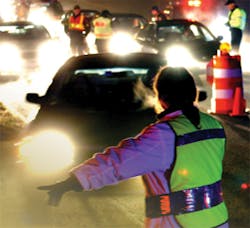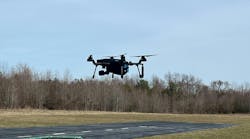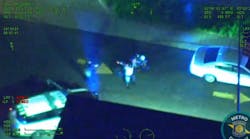At 3 p.m. on a Saturday in June 2007, an SUV loaded with propane canisters was deliberately driven into the glass entrance doors of the main airport terminal at Scotland's Glasgow International Airport and set ablaze. The canisters did not detonate, and security bollards outside the entrance prevented the vehicle from entering the terminal.
The incident, however, reveals the relative ease with which explosive devices can penetrate airport security schemes, illustrating that absolute protection of strategic national infrastructure components like airports is impossible.
Vehicle traffic, entrance roads and perimeter fences cannot be monitored at all times due to limited police and security resources, leaving airports largely vulnerable. Dallas-Fort Worth Airport sprawls over 28 square miles. Denver International Airport (52 square miles) is twice the size of Manhattan.
This lurking security exposure is aggravated by the fact that terrorists can study security arrangements that already exist, and exploit any predictable patterns to their advantage. Terrorism is only one enemy; predictability is the other.
"Randomizing schedules for patrolling, vehicle checking and explosive monitoring is thus an important tool in the police arsenal to avoid the vulnerability that results from predictability," says Milind Tambe, a professor of computer science at the University of Southern California (USC).
Tambe was instrumental in the emergence of a new security system in use at Los Angeles International Airport. The program, called Assistant for Randomized Monitoring Over Routes, or ARMOR, is controlled by a sophisticated computer system based on game theory.
Game theory is a branch of applied mathematics that attempts to mathematically capture behavior in strategic situations, in which one individual's success in making choices depends on the choices of others. Game theory, generally credited to mathematician John von Neumann in 1944, and later refined by mathematician John Forbes Nash in 1950, was initially developed to analyze competitions in which one individual does better at another's expense. It has subsequently been expanded to treat a range of scientific and social interactions.
In this particular game, police attempt to preemptively counter terrorist strategy by anticipating future behavior based on the analysis of past behavior, while at the same time randomizing police behavior to lessen or eliminate predictability of deployments and operations.
"The ARMOR system provides an intelligent approach for randomized patrolling, monitoring or vehicle checking," says Tambe, who is with the Center for Risk and Economic Analysis of Terrorism Events (CREATE), a Department of Homeland Security (DHS) Center of Excellence based at USC. CREATE works with government agencies and other researchers to evaluate the risks, costs and consequences of terrorism. The center helps policy-makers set priorities and find the best, most efficient ways to counter threats and prevent attacks.
The ARMOR system does not merely toss dice to determine a random schedule. That might generate randomization, but would not guarantee, quality of the security provided.
"The key to ARMOR is its game theory foundation, which provides intelligent weights in randomization," Tambe says. "That means the dice are intelligently loaded, yielding results that allow quality guarantees on the protection provided."
How it worksARMOR considers the actions of law enforcement agencies against adversaries as a strategic game. Law enforcement agencies act first in this game - creating security arrangements, setting up defense systems and securing vulnerable areas. Adversaries have a second-mover advantage and can observe these arrangements to plan an attack. Terrorists get to observe patrols, shifts and techniques while attempting to discover predictable patterns.
The security game is repeated every day, or even every shift, giving both sides ample chance to learn and adjust. In game theory, interactions between police and adversaries are called "Bayesian Stackelberg" games.
What that means in the case of LAX is, users input the locations of routine, random vehicle checkpoints, canine search routes, any security breaches or suspicious activity, as well as data on possible terrorist targets and their relative importance. All of these are subject to change from day to day or hour to hour.
ARMOR then processes the data and plots random decisions based on calculated probabilities of a terrorist attack at those locations, using advanced mathematical algorithms. In the LAX system, this typically takes less than 90 seconds. Airport police then receive a randomized model of where to go, and when. Tambe believes the system provides security with airtight unpredictability. "My research group created the fastest algorithms available today to solve such games," he says. "Without these algorithms, we would find it impractical to solve such games."
Before the airport began using ARMOR, LAX dispatchers attempted to shuffle schedules and vary checkpoint sites and deployment times. But Tambe says what LAX was doing was not statistically random, it was merely mixing things up.
LAX police now have systematized, true randomization.
"It is now extremely difficult for anyone to predict LAX police operations," Tambe says.
What would happen if terrorists were to get a copy of the software? Couldn't they solve the predictability puzzle to their own advantage? Tambe doubts it.
"Even if they got the software and all the inputs, it would be like rolling 50 different dice and expecting to correctly roll the same combination on all 50 pairs," he says.
Six-month trialARMOR was first deployed at LAX as a six-month pilot program in August 2007. The first exercise was to use ARMOR to randomize vehicle checkpoints on Century Boulevard, the airport's primary access road. In February 2008, officials judged the checkpoint trial period a success and put ARMOR in the hands of LAX police for routine operational use.
James Butts Jr., deputy executive director of Los Angeles World Airports (LAWA), the LAX parent organization, says while ARMOR is presently being used in the deployment of officers at vehicle checkpoint locations, it will soon be employed to randomly schedule LAX's 32 explosive detection canine teams.
Butts says the ARMOR system has made deployment decisions more efficient and focused, but not necessarily easier. He adds the artificial intelligence program allows users to construct tables of assumptions, which are factored into deployment decisions, allowing intelligent randomization of deployments.
However, the program is only as good as the assumptions built into its logic engine, he adds.
"The system has application in any area where there is sufficient information on past threats and plots, whether completed or attempted, that can be analyzed to develop patterns of behavior," Butts explains.
After the pending canine deployment, LAX police anticipate leveraging the program to determine deployment of patrol, bicycle officers and other airport police resources.
Meanwhile, ARMOR is attracting attention from coast to coast. Other airports, law enforcement agencies and even commercial businesses are showing interest. LAX has received inquiries from a host of federal agencies, and from countries as far away as India. Recently, LAX officials briefed the Transportation Security Administration in anticipation of using the program to randomize federal air marshal deployment on flights.
Although ARMOR requires customization for each new customer, these changes are not prohibitive.
"To deploy at a new location, which has completely new types of requirements, potentially requires creating new algorithms," Tambe says.
LAX-USC NexusARMOR grew out of an LAX-USC nexus. CREATE's associate director, Erroll Southers, also happens to be LAWA's chief of Homeland Security and Intelligence. Southers is a former FBI special agent assigned to counterterrorism, foreign counter intelligence and SWAT.
"When I arrived at LAX in 2007, I became aware of the vehicle checkpoints and the need to randomize their deployment," Southers says. Subsequently, Southers facilitated a meeting between his team at CREATE, of which Tambe was a part, and the LAX Police Department to discuss the feasibility of a pilot program. The meeting resulted in the ARMOR system.
The ARMOR system has such unlimited potential in homeland protection that Congress was recently briefed. In May, Southers told the full Congressional Committee on Homeland Security that the al Qaeda planning cycle depends on the comprehensive situational awareness acquired via pre-attack surveillance and reconnaissance of the intended target.
"It is most important for the attackers to determine the design and level of physical security, including protective policies, procedures and technology," Southers says.
Randomization prevents this.
"It is a proven fact that randomness increases security," Southers told Congress. "Randomization methodology was originally proposed by CREATE to assist in the deployment strategy of unmanned aerial vehicles over Afghanistan."
Southers calls commercial aviation the most institutionally hardened critical infrastructure since September 11, 2001, yet cautions that it remains a target, as the incident last summer in Scotland reveals. "We should learn from failed, as well as successful attacks because, while our vulnerabilities are unlimited, our resources are not," he says.
Sustainability is a critical component of resiliency.
Southers says we must facilitate the link between the laboratory and the operational world.
"Our best practices clearly illustrate the potential when these relationships are realized," he notes.
ARMOR is a good example.
Douglas Page ([email protected]) is a science/technology writer living in Pine Mountain, California.



